Health Law and Policy Module: Addressing Health Disparities in Vietnam
VerifiedAdded on 2022/10/02
|13
|3187
|26
Essay
AI Summary
This essay addresses the critical need for health law reform in Vietnam, particularly concerning the 'Right to Health' and the persistent disparities in maternal and child healthcare services among ethnic minorities. It highlights the nation's challenges in achieving Millennium Development Goals related to maternal and child mortality, emphasizing that these issues reflect a violation of citizens' right to health as defined by the World Health Organization. The essay examines the current international and regional legal frameworks, including the United Nations Declaration of Human Rights and the ASEAN Human Rights Declaration, while noting the absence of a national law on the right to health in Vietnam. It proposes institutional and legal mechanisms, such as mandatory reporting by the Vietnamese government to the United Nations Committee on the Rights of the Child and collaborative efforts between international bodies and Vietnamese ministries, to improve healthcare outcomes. The essay also acknowledges potential shortcomings in existing frameworks and suggests strategies, including strengthening maternal care policies and incorporating preventable diseases in the UNCRC's Optional Protocols. Ultimately, the essay advocates for comprehensive reforms to address healthcare inequities and ensure the right to health for all individuals in Vietnam.

Running head: HEALTH LAW AND POLICY MODULE REOFORM
HEALTH LAW AND POLICY MODULE REFORM
Name of the Student:
Name of the University:
Author note:
HEALTH LAW AND POLICY MODULE REFORM
Name of the Student:
Name of the University:
Author note:
Paraphrase This Document
Need a fresh take? Get an instant paraphrase of this document with our AI Paraphraser

1HEALTH LAW AND POLICY MODULE REFORM
Introduction
In an attempt to improve the outcomes of health across mothers and their children,
Vietnam has achieved commendable strides in maternal and child healthcare. Despite such
progress, several ethnic minority groups in the nation continue to encounter inequities and
discrimination in terms of access and availability of optimum maternal health and childcare
services.1 The following law reform proposal aims to shed light on the need for health law
change and reform in the country of Vietnam, with respect to the citizens’ ‘Right to Health’
considering existing issues of disparities and inequities in maternal and child care services in the
nation across ethnic minorities.
Discussion
Identified Health Issue
According to the Millennium Development Goals (MDGs) 4 and 5, established by the
United Nations (UN) countries must strive to reduce rates of mortality in children and ensure
positive health outcomes in maternal health.2 As reported by UNICEF, the national rates of
maternal mortality and mortality across children under the age of 5, have reduced by four times
and by half, respectively. It has been estimated by United Nations International Children’s
Emergency Fund (UNICEF), however, that Vietnam’s adherence to the MDGs mentioned
previously still continues to be considerably futile. UNICEF denotes that every year the nation
encounters 10, 000 deaths cross neonates and 600 dates across mothers, implying that children
1 See Aiga, Hirotsugu, Vinh Duc Nguyen, Cuong Dinh Nguyen, Tho Thi Thi Nguyen, and Lien Thi Phuong Nguyen.
"Knowledge, attitude and practices: assessing maternal and child health care handbook intervention in
Vietnam." BMC Public Health 16, no. 1 (2015): 129.
2 See World Health Organization. 2019. "WHO | Millennium Development Goals (Mdgs)". Who.Int.
https://www.who.int/topics/millennium_development_goals/about/en/.
Introduction
In an attempt to improve the outcomes of health across mothers and their children,
Vietnam has achieved commendable strides in maternal and child healthcare. Despite such
progress, several ethnic minority groups in the nation continue to encounter inequities and
discrimination in terms of access and availability of optimum maternal health and childcare
services.1 The following law reform proposal aims to shed light on the need for health law
change and reform in the country of Vietnam, with respect to the citizens’ ‘Right to Health’
considering existing issues of disparities and inequities in maternal and child care services in the
nation across ethnic minorities.
Discussion
Identified Health Issue
According to the Millennium Development Goals (MDGs) 4 and 5, established by the
United Nations (UN) countries must strive to reduce rates of mortality in children and ensure
positive health outcomes in maternal health.2 As reported by UNICEF, the national rates of
maternal mortality and mortality across children under the age of 5, have reduced by four times
and by half, respectively. It has been estimated by United Nations International Children’s
Emergency Fund (UNICEF), however, that Vietnam’s adherence to the MDGs mentioned
previously still continues to be considerably futile. UNICEF denotes that every year the nation
encounters 10, 000 deaths cross neonates and 600 dates across mothers, implying that children
1 See Aiga, Hirotsugu, Vinh Duc Nguyen, Cuong Dinh Nguyen, Tho Thi Thi Nguyen, and Lien Thi Phuong Nguyen.
"Knowledge, attitude and practices: assessing maternal and child health care handbook intervention in
Vietnam." BMC Public Health 16, no. 1 (2015): 129.
2 See World Health Organization. 2019. "WHO | Millennium Development Goals (Mdgs)". Who.Int.
https://www.who.int/topics/millennium_development_goals/about/en/.
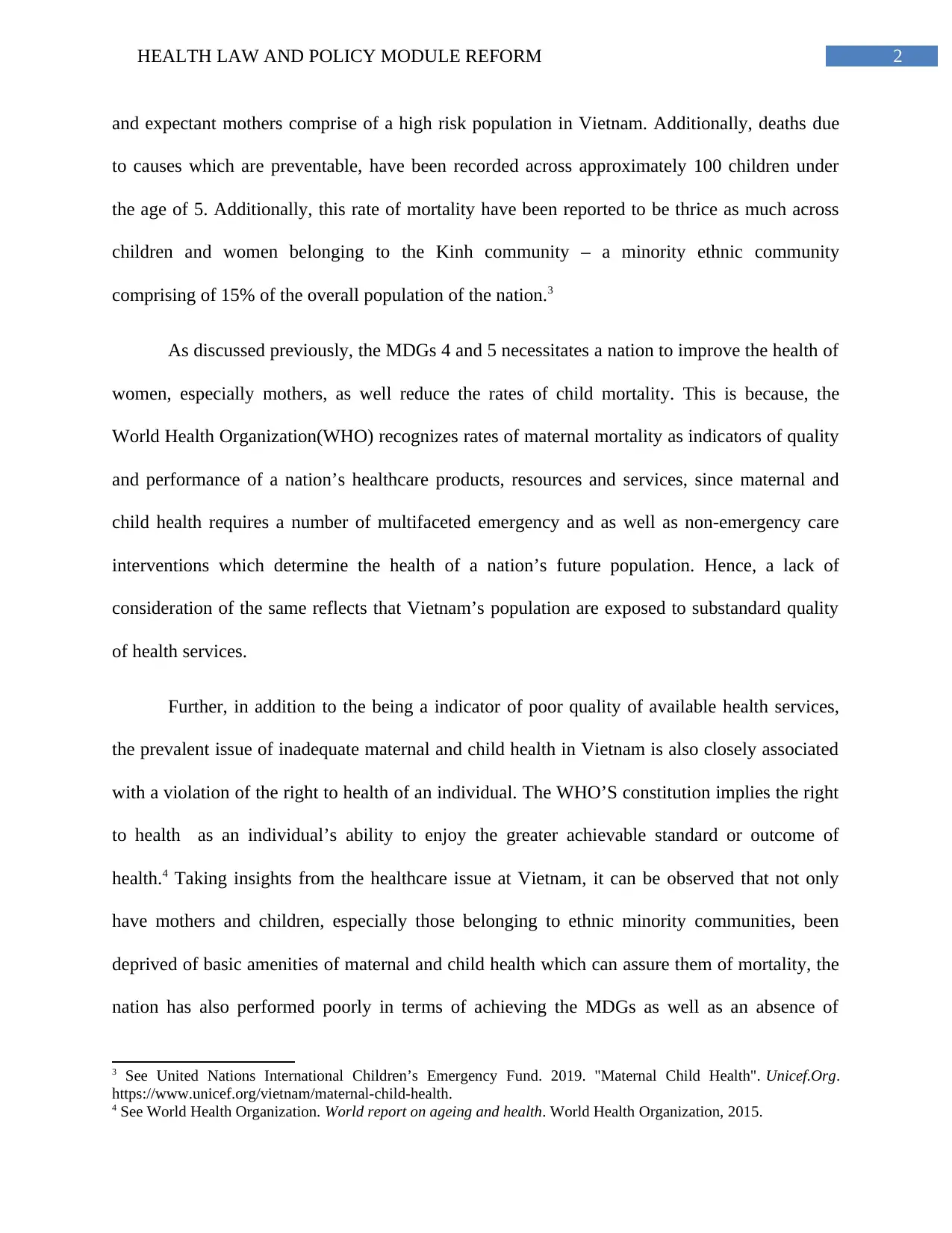
2HEALTH LAW AND POLICY MODULE REFORM
and expectant mothers comprise of a high risk population in Vietnam. Additionally, deaths due
to causes which are preventable, have been recorded across approximately 100 children under
the age of 5. Additionally, this rate of mortality have been reported to be thrice as much across
children and women belonging to the Kinh community – a minority ethnic community
comprising of 15% of the overall population of the nation.3
As discussed previously, the MDGs 4 and 5 necessitates a nation to improve the health of
women, especially mothers, as well reduce the rates of child mortality. This is because, the
World Health Organization(WHO) recognizes rates of maternal mortality as indicators of quality
and performance of a nation’s healthcare products, resources and services, since maternal and
child health requires a number of multifaceted emergency and as well as non-emergency care
interventions which determine the health of a nation’s future population. Hence, a lack of
consideration of the same reflects that Vietnam’s population are exposed to substandard quality
of health services.
Further, in addition to the being a indicator of poor quality of available health services,
the prevalent issue of inadequate maternal and child health in Vietnam is also closely associated
with a violation of the right to health of an individual. The WHO’S constitution implies the right
to health as an individual’s ability to enjoy the greater achievable standard or outcome of
health.4 Taking insights from the healthcare issue at Vietnam, it can be observed that not only
have mothers and children, especially those belonging to ethnic minority communities, been
deprived of basic amenities of maternal and child health which can assure them of mortality, the
nation has also performed poorly in terms of achieving the MDGs as well as an absence of
3 See United Nations International Children’s Emergency Fund. 2019. "Maternal Child Health". Unicef.Org.
https://www.unicef.org/vietnam/maternal-child-health.
4 See World Health Organization. World report on ageing and health. World Health Organization, 2015.
and expectant mothers comprise of a high risk population in Vietnam. Additionally, deaths due
to causes which are preventable, have been recorded across approximately 100 children under
the age of 5. Additionally, this rate of mortality have been reported to be thrice as much across
children and women belonging to the Kinh community – a minority ethnic community
comprising of 15% of the overall population of the nation.3
As discussed previously, the MDGs 4 and 5 necessitates a nation to improve the health of
women, especially mothers, as well reduce the rates of child mortality. This is because, the
World Health Organization(WHO) recognizes rates of maternal mortality as indicators of quality
and performance of a nation’s healthcare products, resources and services, since maternal and
child health requires a number of multifaceted emergency and as well as non-emergency care
interventions which determine the health of a nation’s future population. Hence, a lack of
consideration of the same reflects that Vietnam’s population are exposed to substandard quality
of health services.
Further, in addition to the being a indicator of poor quality of available health services,
the prevalent issue of inadequate maternal and child health in Vietnam is also closely associated
with a violation of the right to health of an individual. The WHO’S constitution implies the right
to health as an individual’s ability to enjoy the greater achievable standard or outcome of
health.4 Taking insights from the healthcare issue at Vietnam, it can be observed that not only
have mothers and children, especially those belonging to ethnic minority communities, been
deprived of basic amenities of maternal and child health which can assure them of mortality, the
nation has also performed poorly in terms of achieving the MDGs as well as an absence of
3 See United Nations International Children’s Emergency Fund. 2019. "Maternal Child Health". Unicef.Org.
https://www.unicef.org/vietnam/maternal-child-health.
4 See World Health Organization. World report on ageing and health. World Health Organization, 2015.
⊘ This is a preview!⊘
Do you want full access?
Subscribe today to unlock all pages.

Trusted by 1+ million students worldwide

3HEALTH LAW AND POLICY MODULE REFORM
decent reduction in rates of maternal mortality – a major indicator, as discussed previously, of
the availability of quality health services in a nation. Such associations between the WHO’s
postulation on health and the prevalence of poor outcomes of maternal and child health in
Vietnam, clearly demonstrate that the citizens’ right to health is undergoing a serious violation.5
Further, the association between human rights and health is evident in the
recommendations by Jonathan Mann, one of the most well known advocates and pioneers of
human health and associated rights on an international scale. In his transformative approach to
human rights and health, Mann denotes that human rights are violated when a nation’s political
and social inadequacies in terms of lack of adequate healthcare policies and services have a
negative impact on population’s health and wellbeing – the scale of which can be quantified or
measured.6 Hence, in the case of Vietnam, the current issue of poor maternal and child care
outcomes is a serious violation of the rights to health considering that present maternal and
neonatal services are affecting the health and wellbeing of the nation, as measured by rates of
maternal, neonatal and under-5 mortality.7
Additionally, according to the General Comment by the United Nation’s Committee on
Economic, Social and Cultural Rights, also considers the presence of equity or an absence of
discrimination in healthcare services as a key determinant of a nation’s achievement of the right
to health across every citizen.8 In the case of Vietnam, the WHO has reported a number of
5 See Aiga, Hirotsugu, Vinh Duc Nguyen, Cuong Dinh Nguyen, Tho Thi Thi Nguyen, and Lien Thi Phuong Nguyen.
"Fragmented implementation of maternal and child health home-based records in Vietnam: need for
integration." Global health action 9, no. 1 (2016): 29924.
6 See Akerman, Marco. "Jonathan Mann Health and Human Rights Lecture: Global Health Equity and Urban
Design." (2017).
7 See Minh, Hoang Van, Kim Bao Giang, Luu Ngoc Hoat, Le Hong Chung, Tran Thi Giang Huong, Nguyen Thi
Kim Phuong, and Nicole B. Valentine. "Analysis of selected social determinants of health and their relationships
with maternal health service coverage and child mortality in Vietnam." Global health action 9, no. 1 (2016): 28836.
8 See Müller, Amrei. "Limitations to and derogations from economic, social and cultural rights." In Economic,
Social and Cultural Rights, pp. 113-158. Routledge, 2017.
decent reduction in rates of maternal mortality – a major indicator, as discussed previously, of
the availability of quality health services in a nation. Such associations between the WHO’s
postulation on health and the prevalence of poor outcomes of maternal and child health in
Vietnam, clearly demonstrate that the citizens’ right to health is undergoing a serious violation.5
Further, the association between human rights and health is evident in the
recommendations by Jonathan Mann, one of the most well known advocates and pioneers of
human health and associated rights on an international scale. In his transformative approach to
human rights and health, Mann denotes that human rights are violated when a nation’s political
and social inadequacies in terms of lack of adequate healthcare policies and services have a
negative impact on population’s health and wellbeing – the scale of which can be quantified or
measured.6 Hence, in the case of Vietnam, the current issue of poor maternal and child care
outcomes is a serious violation of the rights to health considering that present maternal and
neonatal services are affecting the health and wellbeing of the nation, as measured by rates of
maternal, neonatal and under-5 mortality.7
Additionally, according to the General Comment by the United Nation’s Committee on
Economic, Social and Cultural Rights, also considers the presence of equity or an absence of
discrimination in healthcare services as a key determinant of a nation’s achievement of the right
to health across every citizen.8 In the case of Vietnam, the WHO has reported a number of
5 See Aiga, Hirotsugu, Vinh Duc Nguyen, Cuong Dinh Nguyen, Tho Thi Thi Nguyen, and Lien Thi Phuong Nguyen.
"Fragmented implementation of maternal and child health home-based records in Vietnam: need for
integration." Global health action 9, no. 1 (2016): 29924.
6 See Akerman, Marco. "Jonathan Mann Health and Human Rights Lecture: Global Health Equity and Urban
Design." (2017).
7 See Minh, Hoang Van, Kim Bao Giang, Luu Ngoc Hoat, Le Hong Chung, Tran Thi Giang Huong, Nguyen Thi
Kim Phuong, and Nicole B. Valentine. "Analysis of selected social determinants of health and their relationships
with maternal health service coverage and child mortality in Vietnam." Global health action 9, no. 1 (2016): 28836.
8 See Müller, Amrei. "Limitations to and derogations from economic, social and cultural rights." In Economic,
Social and Cultural Rights, pp. 113-158. Routledge, 2017.
Paraphrase This Document
Need a fresh take? Get an instant paraphrase of this document with our AI Paraphraser

4HEALTH LAW AND POLICY MODULE REFORM
inequities in current maternal and child health services, such as: reduced rates of delivery across
households belonging to a low income group as compared to economically privileged
households, a lack of skilled antenatal health personnel as reported by women in rural regions as
compared to urban areas and an increased rate of household delivery due to lack of health
services, in rural areas, especially women belonging to the Kinh/Hoa community. Thus, in
alignment with the General Comment, the presence of such inequities in maternal and child
health also denotes a violation of right to health in Vietnam.9
Current Legal Framework
The current international legal framework which is of relevance for application in the
issue of poor maternal and child health in Vietnam is the United Nations Declaration of Human
Rights. The key legal components of this international-level governance framework which can
be applied to the issues of lack of affordability, availability and inequity in current maternal and
child health services in Vietnam are Articles 22 to 27, which every citizens’ right to optimum
standards of personal and familial health and wellbeing.10 Additionally, Article 12, of the
International Covenant on Economic, Social and Cultural Rights, is another legal and
international governance framework which can be applied to target the nation’s inability to
achieve reductions in maternal mortality rates, as per its declaration of every citizens’ right to
received the best achievable standards of mental and physical health and wellbeing.11
One the most relevant international legal frameworks considering Vietnam’s poor
neonatal and under-5 health outcomes is the United Nation’s Convention of the Rights of the
9 See Målqvist, Mats, Ornella Lincetto, Nguyen Huy Du, Craig Burgess, and Dinh Thi Phuong Hoa. "Maternal
health care utilization in Viet Nam: increasing ethnic inequity." Bulletin of the World Health Organization 91
(2013): 254-261.
10 Danieli, Yael, Elsa Stamatopoulou, and Clarence Dias. The universal declaration of human rights: Fifty years and
beyond. Routledge, 2018.
11 Donders, Yvonne. "International Covenant on Economic, Social and Cultural Rights: accessibility and the right to
information." (2015).
inequities in current maternal and child health services, such as: reduced rates of delivery across
households belonging to a low income group as compared to economically privileged
households, a lack of skilled antenatal health personnel as reported by women in rural regions as
compared to urban areas and an increased rate of household delivery due to lack of health
services, in rural areas, especially women belonging to the Kinh/Hoa community. Thus, in
alignment with the General Comment, the presence of such inequities in maternal and child
health also denotes a violation of right to health in Vietnam.9
Current Legal Framework
The current international legal framework which is of relevance for application in the
issue of poor maternal and child health in Vietnam is the United Nations Declaration of Human
Rights. The key legal components of this international-level governance framework which can
be applied to the issues of lack of affordability, availability and inequity in current maternal and
child health services in Vietnam are Articles 22 to 27, which every citizens’ right to optimum
standards of personal and familial health and wellbeing.10 Additionally, Article 12, of the
International Covenant on Economic, Social and Cultural Rights, is another legal and
international governance framework which can be applied to target the nation’s inability to
achieve reductions in maternal mortality rates, as per its declaration of every citizens’ right to
received the best achievable standards of mental and physical health and wellbeing.11
One the most relevant international legal frameworks considering Vietnam’s poor
neonatal and under-5 health outcomes is the United Nation’s Convention of the Rights of the
9 See Målqvist, Mats, Ornella Lincetto, Nguyen Huy Du, Craig Burgess, and Dinh Thi Phuong Hoa. "Maternal
health care utilization in Viet Nam: increasing ethnic inequity." Bulletin of the World Health Organization 91
(2013): 254-261.
10 Danieli, Yael, Elsa Stamatopoulou, and Clarence Dias. The universal declaration of human rights: Fifty years and
beyond. Routledge, 2018.
11 Donders, Yvonne. "International Covenant on Economic, Social and Cultural Rights: accessibility and the right to
information." (2015).
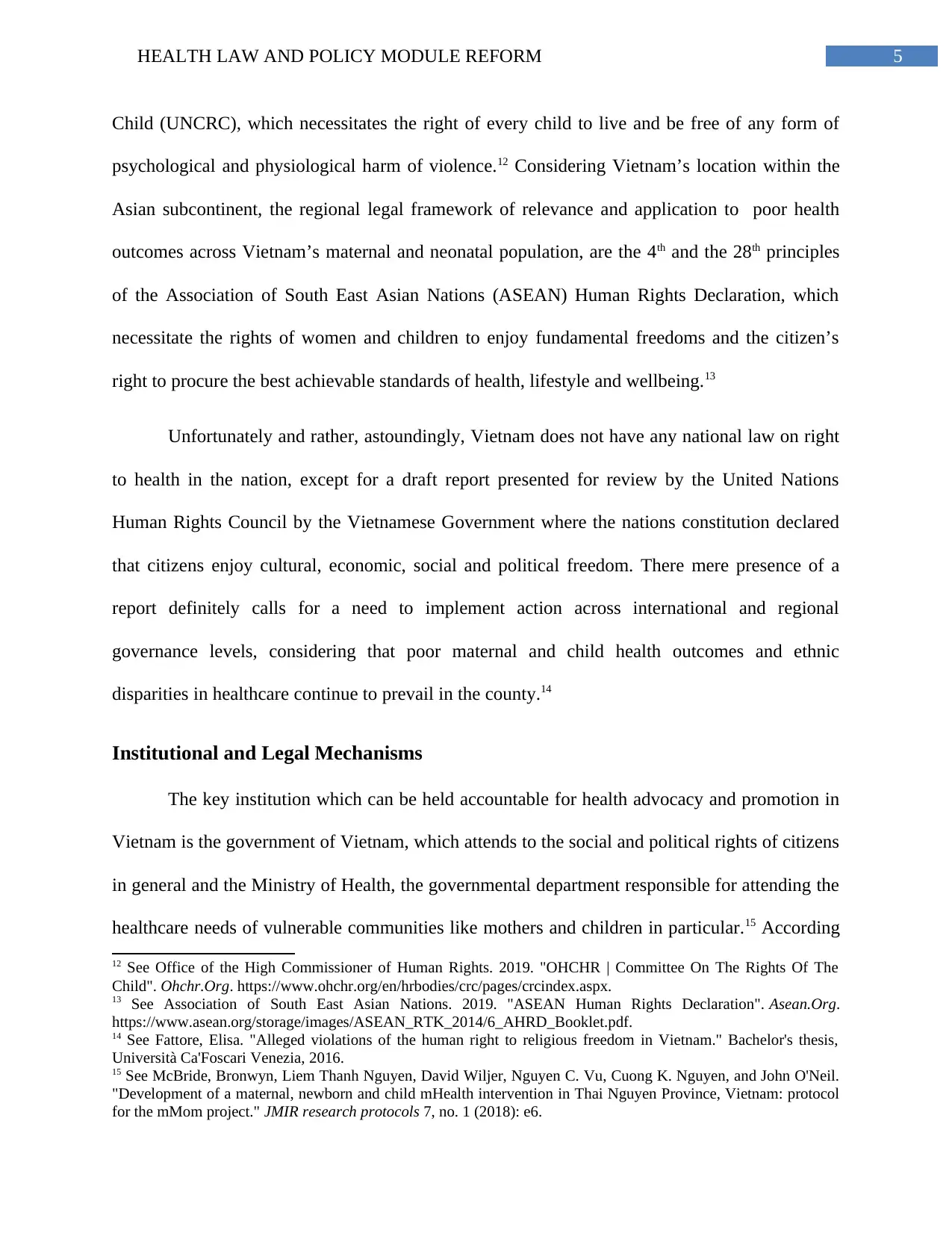
5HEALTH LAW AND POLICY MODULE REFORM
Child (UNCRC), which necessitates the right of every child to live and be free of any form of
psychological and physiological harm of violence.12 Considering Vietnam’s location within the
Asian subcontinent, the regional legal framework of relevance and application to poor health
outcomes across Vietnam’s maternal and neonatal population, are the 4th and the 28th principles
of the Association of South East Asian Nations (ASEAN) Human Rights Declaration, which
necessitate the rights of women and children to enjoy fundamental freedoms and the citizen’s
right to procure the best achievable standards of health, lifestyle and wellbeing.13
Unfortunately and rather, astoundingly, Vietnam does not have any national law on right
to health in the nation, except for a draft report presented for review by the United Nations
Human Rights Council by the Vietnamese Government where the nations constitution declared
that citizens enjoy cultural, economic, social and political freedom. There mere presence of a
report definitely calls for a need to implement action across international and regional
governance levels, considering that poor maternal and child health outcomes and ethnic
disparities in healthcare continue to prevail in the county.14
Institutional and Legal Mechanisms
The key institution which can be held accountable for health advocacy and promotion in
Vietnam is the government of Vietnam, which attends to the social and political rights of citizens
in general and the Ministry of Health, the governmental department responsible for attending the
healthcare needs of vulnerable communities like mothers and children in particular.15 According
12 See Office of the High Commissioner of Human Rights. 2019. "OHCHR | Committee On The Rights Of The
Child". Ohchr.Org. https://www.ohchr.org/en/hrbodies/crc/pages/crcindex.aspx.
13 See Association of South East Asian Nations. 2019. "ASEAN Human Rights Declaration". Asean.Org.
https://www.asean.org/storage/images/ASEAN_RTK_2014/6_AHRD_Booklet.pdf.
14 See Fattore, Elisa. "Alleged violations of the human right to religious freedom in Vietnam." Bachelor's thesis,
Università Ca'Foscari Venezia, 2016.
15 See McBride, Bronwyn, Liem Thanh Nguyen, David Wiljer, Nguyen C. Vu, Cuong K. Nguyen, and John O'Neil.
"Development of a maternal, newborn and child mHealth intervention in Thai Nguyen Province, Vietnam: protocol
for the mMom project." JMIR research protocols 7, no. 1 (2018): e6.
Child (UNCRC), which necessitates the right of every child to live and be free of any form of
psychological and physiological harm of violence.12 Considering Vietnam’s location within the
Asian subcontinent, the regional legal framework of relevance and application to poor health
outcomes across Vietnam’s maternal and neonatal population, are the 4th and the 28th principles
of the Association of South East Asian Nations (ASEAN) Human Rights Declaration, which
necessitate the rights of women and children to enjoy fundamental freedoms and the citizen’s
right to procure the best achievable standards of health, lifestyle and wellbeing.13
Unfortunately and rather, astoundingly, Vietnam does not have any national law on right
to health in the nation, except for a draft report presented for review by the United Nations
Human Rights Council by the Vietnamese Government where the nations constitution declared
that citizens enjoy cultural, economic, social and political freedom. There mere presence of a
report definitely calls for a need to implement action across international and regional
governance levels, considering that poor maternal and child health outcomes and ethnic
disparities in healthcare continue to prevail in the county.14
Institutional and Legal Mechanisms
The key institution which can be held accountable for health advocacy and promotion in
Vietnam is the government of Vietnam, which attends to the social and political rights of citizens
in general and the Ministry of Health, the governmental department responsible for attending the
healthcare needs of vulnerable communities like mothers and children in particular.15 According
12 See Office of the High Commissioner of Human Rights. 2019. "OHCHR | Committee On The Rights Of The
Child". Ohchr.Org. https://www.ohchr.org/en/hrbodies/crc/pages/crcindex.aspx.
13 See Association of South East Asian Nations. 2019. "ASEAN Human Rights Declaration". Asean.Org.
https://www.asean.org/storage/images/ASEAN_RTK_2014/6_AHRD_Booklet.pdf.
14 See Fattore, Elisa. "Alleged violations of the human right to religious freedom in Vietnam." Bachelor's thesis,
Università Ca'Foscari Venezia, 2016.
15 See McBride, Bronwyn, Liem Thanh Nguyen, David Wiljer, Nguyen C. Vu, Cuong K. Nguyen, and John O'Neil.
"Development of a maternal, newborn and child mHealth intervention in Thai Nguyen Province, Vietnam: protocol
for the mMom project." JMIR research protocols 7, no. 1 (2018): e6.
⊘ This is a preview!⊘
Do you want full access?
Subscribe today to unlock all pages.

Trusted by 1+ million students worldwide
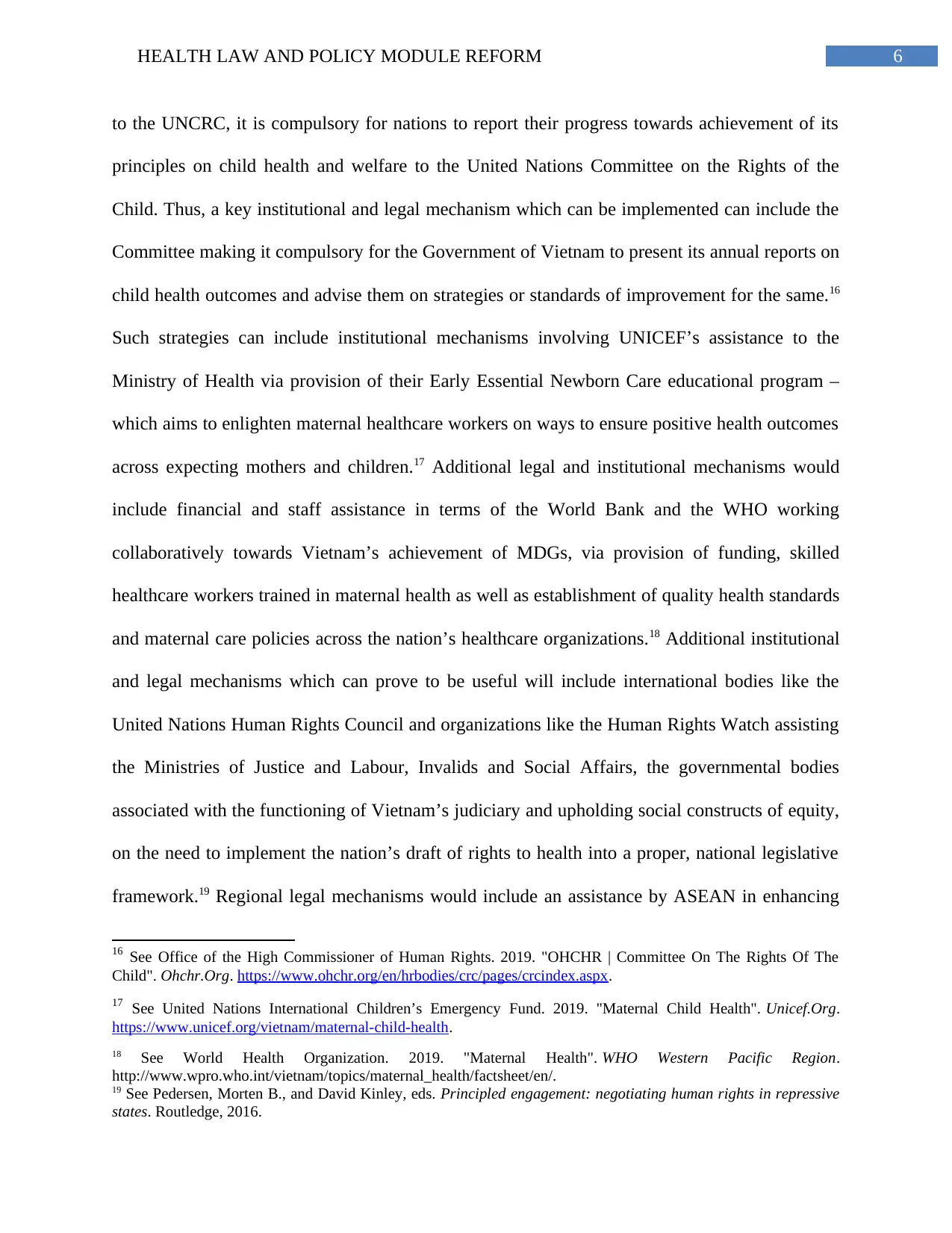
6HEALTH LAW AND POLICY MODULE REFORM
to the UNCRC, it is compulsory for nations to report their progress towards achievement of its
principles on child health and welfare to the United Nations Committee on the Rights of the
Child. Thus, a key institutional and legal mechanism which can be implemented can include the
Committee making it compulsory for the Government of Vietnam to present its annual reports on
child health outcomes and advise them on strategies or standards of improvement for the same.16
Such strategies can include institutional mechanisms involving UNICEF’s assistance to the
Ministry of Health via provision of their Early Essential Newborn Care educational program –
which aims to enlighten maternal healthcare workers on ways to ensure positive health outcomes
across expecting mothers and children.17 Additional legal and institutional mechanisms would
include financial and staff assistance in terms of the World Bank and the WHO working
collaboratively towards Vietnam’s achievement of MDGs, via provision of funding, skilled
healthcare workers trained in maternal health as well as establishment of quality health standards
and maternal care policies across the nation’s healthcare organizations.18 Additional institutional
and legal mechanisms which can prove to be useful will include international bodies like the
United Nations Human Rights Council and organizations like the Human Rights Watch assisting
the Ministries of Justice and Labour, Invalids and Social Affairs, the governmental bodies
associated with the functioning of Vietnam’s judiciary and upholding social constructs of equity,
on the need to implement the nation’s draft of rights to health into a proper, national legislative
framework.19 Regional legal mechanisms would include an assistance by ASEAN in enhancing
16 See Office of the High Commissioner of Human Rights. 2019. "OHCHR | Committee On The Rights Of The
Child". Ohchr.Org. https://www.ohchr.org/en/hrbodies/crc/pages/crcindex.aspx.
17 See United Nations International Children’s Emergency Fund. 2019. "Maternal Child Health". Unicef.Org.
https://www.unicef.org/vietnam/maternal-child-health.
18 See World Health Organization. 2019. "Maternal Health". WHO Western Pacific Region.
http://www.wpro.who.int/vietnam/topics/maternal_health/factsheet/en/.
19 See Pedersen, Morten B., and David Kinley, eds. Principled engagement: negotiating human rights in repressive
states. Routledge, 2016.
to the UNCRC, it is compulsory for nations to report their progress towards achievement of its
principles on child health and welfare to the United Nations Committee on the Rights of the
Child. Thus, a key institutional and legal mechanism which can be implemented can include the
Committee making it compulsory for the Government of Vietnam to present its annual reports on
child health outcomes and advise them on strategies or standards of improvement for the same.16
Such strategies can include institutional mechanisms involving UNICEF’s assistance to the
Ministry of Health via provision of their Early Essential Newborn Care educational program –
which aims to enlighten maternal healthcare workers on ways to ensure positive health outcomes
across expecting mothers and children.17 Additional legal and institutional mechanisms would
include financial and staff assistance in terms of the World Bank and the WHO working
collaboratively towards Vietnam’s achievement of MDGs, via provision of funding, skilled
healthcare workers trained in maternal health as well as establishment of quality health standards
and maternal care policies across the nation’s healthcare organizations.18 Additional institutional
and legal mechanisms which can prove to be useful will include international bodies like the
United Nations Human Rights Council and organizations like the Human Rights Watch assisting
the Ministries of Justice and Labour, Invalids and Social Affairs, the governmental bodies
associated with the functioning of Vietnam’s judiciary and upholding social constructs of equity,
on the need to implement the nation’s draft of rights to health into a proper, national legislative
framework.19 Regional legal mechanisms would include an assistance by ASEAN in enhancing
16 See Office of the High Commissioner of Human Rights. 2019. "OHCHR | Committee On The Rights Of The
Child". Ohchr.Org. https://www.ohchr.org/en/hrbodies/crc/pages/crcindex.aspx.
17 See United Nations International Children’s Emergency Fund. 2019. "Maternal Child Health". Unicef.Org.
https://www.unicef.org/vietnam/maternal-child-health.
18 See World Health Organization. 2019. "Maternal Health". WHO Western Pacific Region.
http://www.wpro.who.int/vietnam/topics/maternal_health/factsheet/en/.
19 See Pedersen, Morten B., and David Kinley, eds. Principled engagement: negotiating human rights in repressive
states. Routledge, 2016.
Paraphrase This Document
Need a fresh take? Get an instant paraphrase of this document with our AI Paraphraser
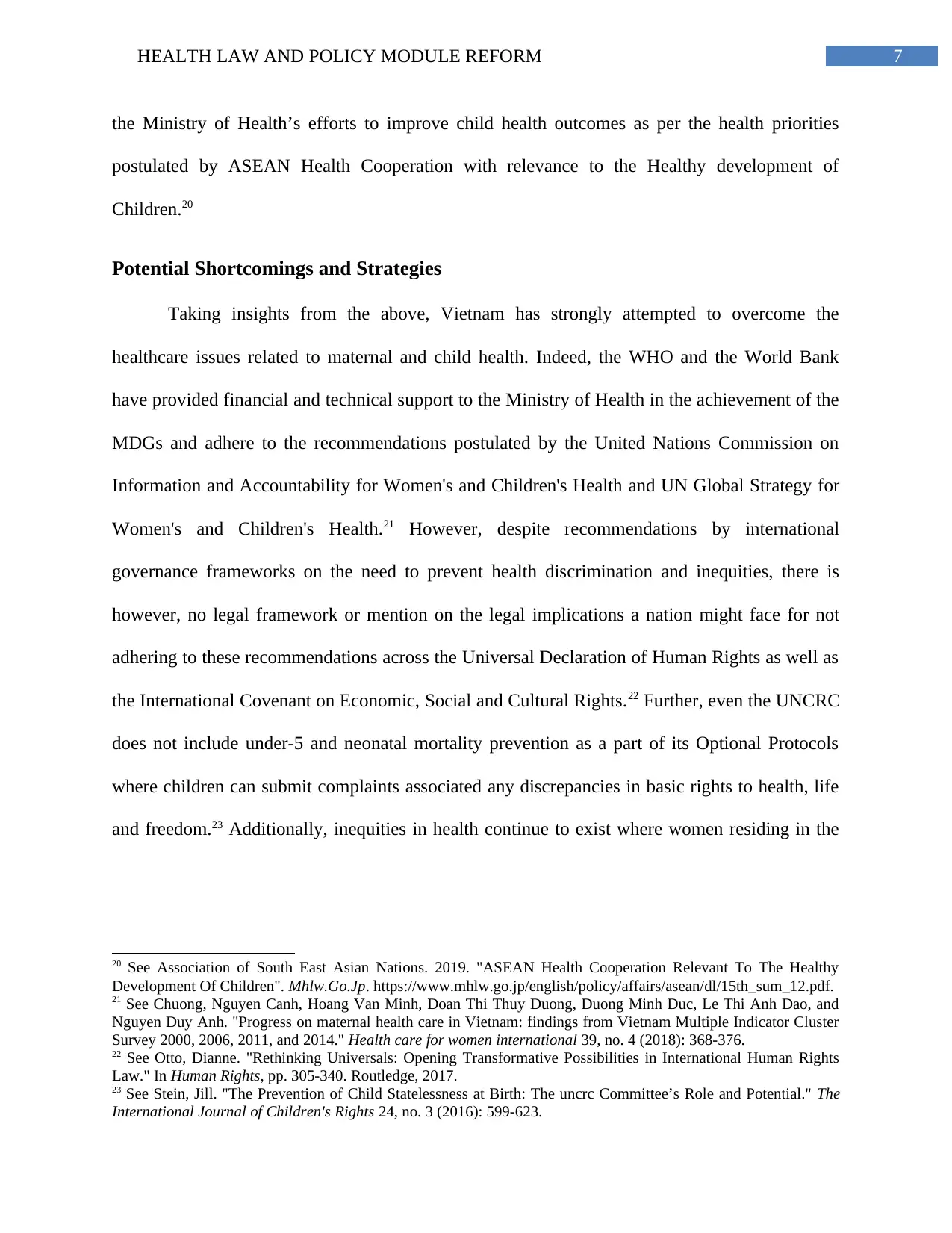
7HEALTH LAW AND POLICY MODULE REFORM
the Ministry of Health’s efforts to improve child health outcomes as per the health priorities
postulated by ASEAN Health Cooperation with relevance to the Healthy development of
Children.20
Potential Shortcomings and Strategies
Taking insights from the above, Vietnam has strongly attempted to overcome the
healthcare issues related to maternal and child health. Indeed, the WHO and the World Bank
have provided financial and technical support to the Ministry of Health in the achievement of the
MDGs and adhere to the recommendations postulated by the United Nations Commission on
Information and Accountability for Women's and Children's Health and UN Global Strategy for
Women's and Children's Health.21 However, despite recommendations by international
governance frameworks on the need to prevent health discrimination and inequities, there is
however, no legal framework or mention on the legal implications a nation might face for not
adhering to these recommendations across the Universal Declaration of Human Rights as well as
the International Covenant on Economic, Social and Cultural Rights.22 Further, even the UNCRC
does not include under-5 and neonatal mortality prevention as a part of its Optional Protocols
where children can submit complaints associated any discrepancies in basic rights to health, life
and freedom.23 Additionally, inequities in health continue to exist where women residing in the
20 See Association of South East Asian Nations. 2019. "ASEAN Health Cooperation Relevant To The Healthy
Development Of Children". Mhlw.Go.Jp. https://www.mhlw.go.jp/english/policy/affairs/asean/dl/15th_sum_12.pdf.
21 See Chuong, Nguyen Canh, Hoang Van Minh, Doan Thi Thuy Duong, Duong Minh Duc, Le Thi Anh Dao, and
Nguyen Duy Anh. "Progress on maternal health care in Vietnam: findings from Vietnam Multiple Indicator Cluster
Survey 2000, 2006, 2011, and 2014." Health care for women international 39, no. 4 (2018): 368-376.
22 See Otto, Dianne. "Rethinking Universals: Opening Transformative Possibilities in International Human Rights
Law." In Human Rights, pp. 305-340. Routledge, 2017.
23 See Stein, Jill. "The Prevention of Child Statelessness at Birth: The uncrc Committee’s Role and Potential." The
International Journal of Children's Rights 24, no. 3 (2016): 599-623.
the Ministry of Health’s efforts to improve child health outcomes as per the health priorities
postulated by ASEAN Health Cooperation with relevance to the Healthy development of
Children.20
Potential Shortcomings and Strategies
Taking insights from the above, Vietnam has strongly attempted to overcome the
healthcare issues related to maternal and child health. Indeed, the WHO and the World Bank
have provided financial and technical support to the Ministry of Health in the achievement of the
MDGs and adhere to the recommendations postulated by the United Nations Commission on
Information and Accountability for Women's and Children's Health and UN Global Strategy for
Women's and Children's Health.21 However, despite recommendations by international
governance frameworks on the need to prevent health discrimination and inequities, there is
however, no legal framework or mention on the legal implications a nation might face for not
adhering to these recommendations across the Universal Declaration of Human Rights as well as
the International Covenant on Economic, Social and Cultural Rights.22 Further, even the UNCRC
does not include under-5 and neonatal mortality prevention as a part of its Optional Protocols
where children can submit complaints associated any discrepancies in basic rights to health, life
and freedom.23 Additionally, inequities in health continue to exist where women residing in the
20 See Association of South East Asian Nations. 2019. "ASEAN Health Cooperation Relevant To The Healthy
Development Of Children". Mhlw.Go.Jp. https://www.mhlw.go.jp/english/policy/affairs/asean/dl/15th_sum_12.pdf.
21 See Chuong, Nguyen Canh, Hoang Van Minh, Doan Thi Thuy Duong, Duong Minh Duc, Le Thi Anh Dao, and
Nguyen Duy Anh. "Progress on maternal health care in Vietnam: findings from Vietnam Multiple Indicator Cluster
Survey 2000, 2006, 2011, and 2014." Health care for women international 39, no. 4 (2018): 368-376.
22 See Otto, Dianne. "Rethinking Universals: Opening Transformative Possibilities in International Human Rights
Law." In Human Rights, pp. 305-340. Routledge, 2017.
23 See Stein, Jill. "The Prevention of Child Statelessness at Birth: The uncrc Committee’s Role and Potential." The
International Journal of Children's Rights 24, no. 3 (2016): 599-623.
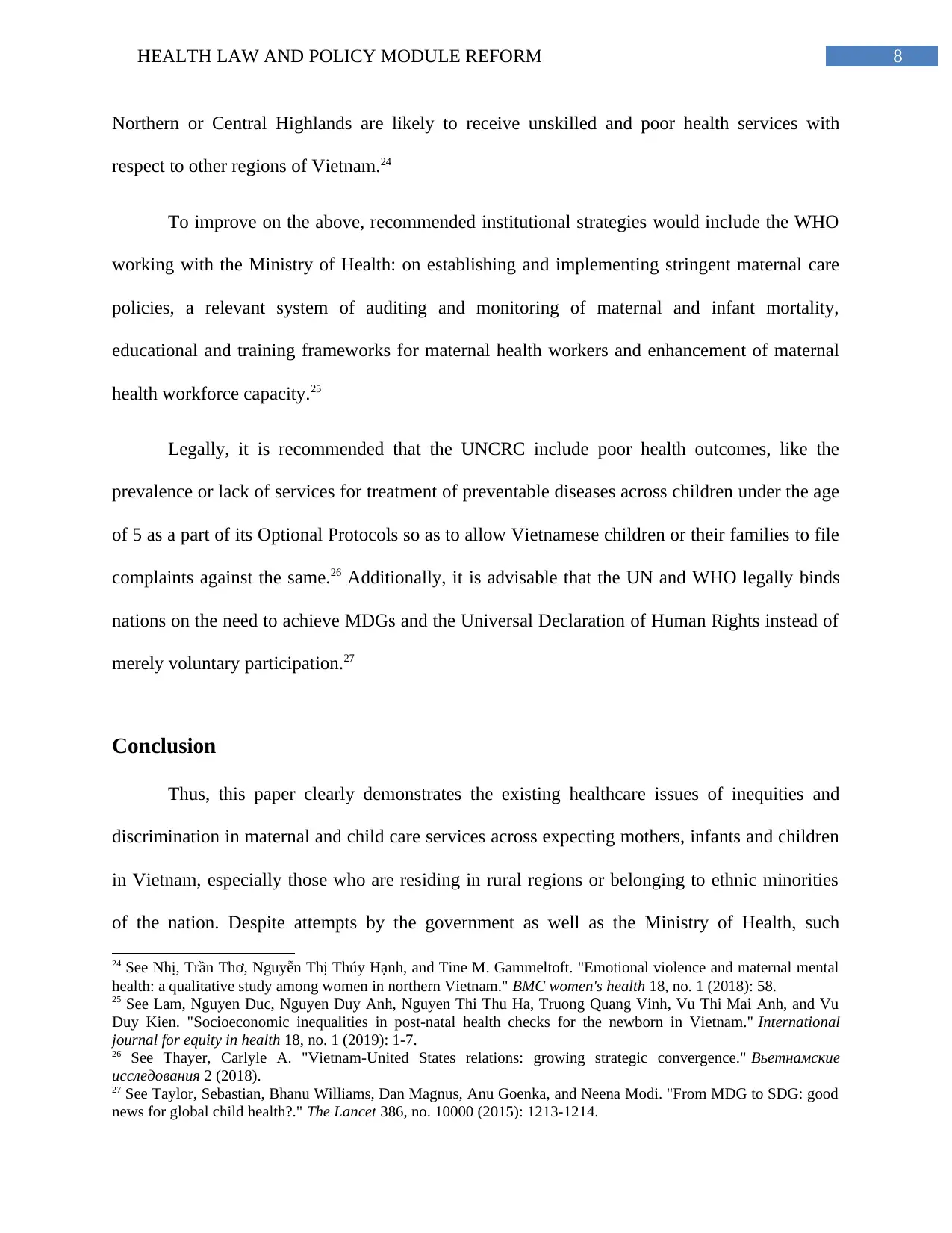
8HEALTH LAW AND POLICY MODULE REFORM
Northern or Central Highlands are likely to receive unskilled and poor health services with
respect to other regions of Vietnam.24
To improve on the above, recommended institutional strategies would include the WHO
working with the Ministry of Health: on establishing and implementing stringent maternal care
policies, a relevant system of auditing and monitoring of maternal and infant mortality,
educational and training frameworks for maternal health workers and enhancement of maternal
health workforce capacity.25
Legally, it is recommended that the UNCRC include poor health outcomes, like the
prevalence or lack of services for treatment of preventable diseases across children under the age
of 5 as a part of its Optional Protocols so as to allow Vietnamese children or their families to file
complaints against the same.26 Additionally, it is advisable that the UN and WHO legally binds
nations on the need to achieve MDGs and the Universal Declaration of Human Rights instead of
merely voluntary participation.27
Conclusion
Thus, this paper clearly demonstrates the existing healthcare issues of inequities and
discrimination in maternal and child care services across expecting mothers, infants and children
in Vietnam, especially those who are residing in rural regions or belonging to ethnic minorities
of the nation. Despite attempts by the government as well as the Ministry of Health, such
24 See Nhị, Trần Thơ, Nguyễn Thị Thúy Hạnh, and Tine M. Gammeltoft. "Emotional violence and maternal mental
health: a qualitative study among women in northern Vietnam." BMC women's health 18, no. 1 (2018): 58.
25 See Lam, Nguyen Duc, Nguyen Duy Anh, Nguyen Thi Thu Ha, Truong Quang Vinh, Vu Thi Mai Anh, and Vu
Duy Kien. "Socioeconomic inequalities in post-natal health checks for the newborn in Vietnam." International
journal for equity in health 18, no. 1 (2019): 1-7.
26 See Thayer, Carlyle A. "Vietnam-United States relations: growing strategic convergence." Вьетнамские
исследования 2 (2018).
27 See Taylor, Sebastian, Bhanu Williams, Dan Magnus, Anu Goenka, and Neena Modi. "From MDG to SDG: good
news for global child health?." The Lancet 386, no. 10000 (2015): 1213-1214.
Northern or Central Highlands are likely to receive unskilled and poor health services with
respect to other regions of Vietnam.24
To improve on the above, recommended institutional strategies would include the WHO
working with the Ministry of Health: on establishing and implementing stringent maternal care
policies, a relevant system of auditing and monitoring of maternal and infant mortality,
educational and training frameworks for maternal health workers and enhancement of maternal
health workforce capacity.25
Legally, it is recommended that the UNCRC include poor health outcomes, like the
prevalence or lack of services for treatment of preventable diseases across children under the age
of 5 as a part of its Optional Protocols so as to allow Vietnamese children or their families to file
complaints against the same.26 Additionally, it is advisable that the UN and WHO legally binds
nations on the need to achieve MDGs and the Universal Declaration of Human Rights instead of
merely voluntary participation.27
Conclusion
Thus, this paper clearly demonstrates the existing healthcare issues of inequities and
discrimination in maternal and child care services across expecting mothers, infants and children
in Vietnam, especially those who are residing in rural regions or belonging to ethnic minorities
of the nation. Despite attempts by the government as well as the Ministry of Health, such
24 See Nhị, Trần Thơ, Nguyễn Thị Thúy Hạnh, and Tine M. Gammeltoft. "Emotional violence and maternal mental
health: a qualitative study among women in northern Vietnam." BMC women's health 18, no. 1 (2018): 58.
25 See Lam, Nguyen Duc, Nguyen Duy Anh, Nguyen Thi Thu Ha, Truong Quang Vinh, Vu Thi Mai Anh, and Vu
Duy Kien. "Socioeconomic inequalities in post-natal health checks for the newborn in Vietnam." International
journal for equity in health 18, no. 1 (2019): 1-7.
26 See Thayer, Carlyle A. "Vietnam-United States relations: growing strategic convergence." Вьетнамские
исследования 2 (2018).
27 See Taylor, Sebastian, Bhanu Williams, Dan Magnus, Anu Goenka, and Neena Modi. "From MDG to SDG: good
news for global child health?." The Lancet 386, no. 10000 (2015): 1213-1214.
⊘ This is a preview!⊘
Do you want full access?
Subscribe today to unlock all pages.

Trusted by 1+ million students worldwide
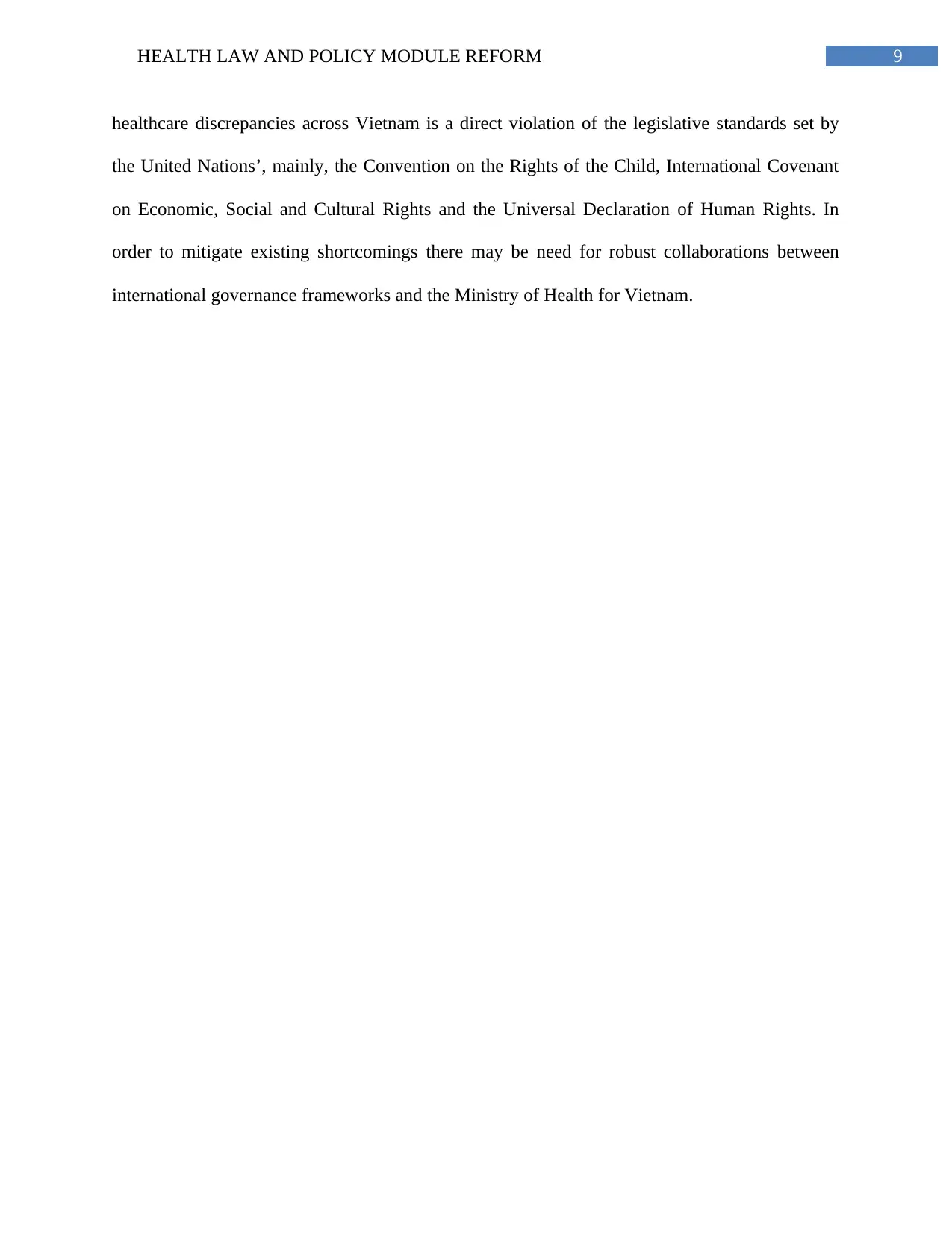
9HEALTH LAW AND POLICY MODULE REFORM
healthcare discrepancies across Vietnam is a direct violation of the legislative standards set by
the United Nations’, mainly, the Convention on the Rights of the Child, International Covenant
on Economic, Social and Cultural Rights and the Universal Declaration of Human Rights. In
order to mitigate existing shortcomings there may be need for robust collaborations between
international governance frameworks and the Ministry of Health for Vietnam.
healthcare discrepancies across Vietnam is a direct violation of the legislative standards set by
the United Nations’, mainly, the Convention on the Rights of the Child, International Covenant
on Economic, Social and Cultural Rights and the Universal Declaration of Human Rights. In
order to mitigate existing shortcomings there may be need for robust collaborations between
international governance frameworks and the Ministry of Health for Vietnam.
Paraphrase This Document
Need a fresh take? Get an instant paraphrase of this document with our AI Paraphraser
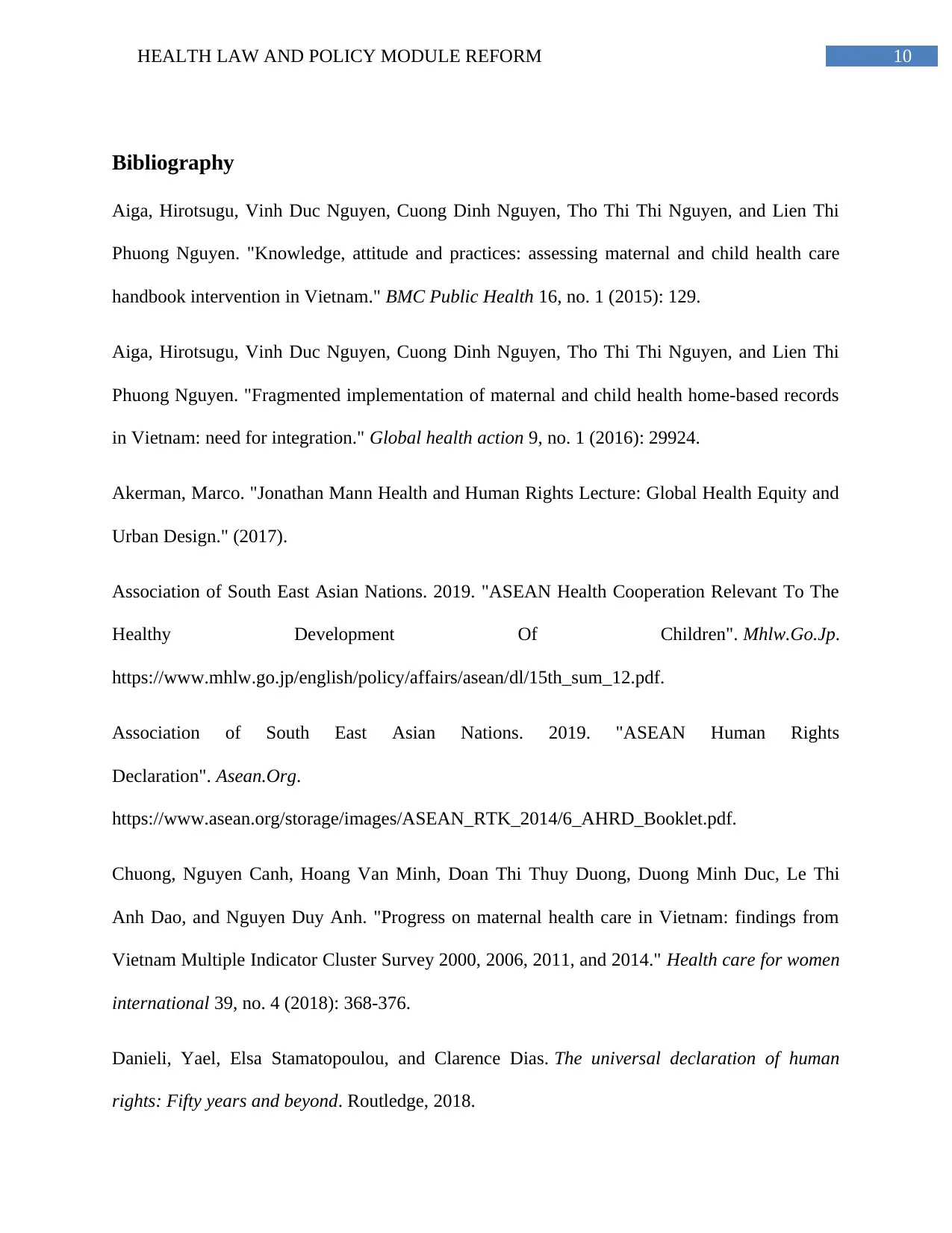
10HEALTH LAW AND POLICY MODULE REFORM
Bibliography
Aiga, Hirotsugu, Vinh Duc Nguyen, Cuong Dinh Nguyen, Tho Thi Thi Nguyen, and Lien Thi
Phuong Nguyen. "Knowledge, attitude and practices: assessing maternal and child health care
handbook intervention in Vietnam." BMC Public Health 16, no. 1 (2015): 129.
Aiga, Hirotsugu, Vinh Duc Nguyen, Cuong Dinh Nguyen, Tho Thi Thi Nguyen, and Lien Thi
Phuong Nguyen. "Fragmented implementation of maternal and child health home-based records
in Vietnam: need for integration." Global health action 9, no. 1 (2016): 29924.
Akerman, Marco. "Jonathan Mann Health and Human Rights Lecture: Global Health Equity and
Urban Design." (2017).
Association of South East Asian Nations. 2019. "ASEAN Health Cooperation Relevant To The
Healthy Development Of Children". Mhlw.Go.Jp.
https://www.mhlw.go.jp/english/policy/affairs/asean/dl/15th_sum_12.pdf.
Association of South East Asian Nations. 2019. "ASEAN Human Rights
Declaration". Asean.Org.
https://www.asean.org/storage/images/ASEAN_RTK_2014/6_AHRD_Booklet.pdf.
Chuong, Nguyen Canh, Hoang Van Minh, Doan Thi Thuy Duong, Duong Minh Duc, Le Thi
Anh Dao, and Nguyen Duy Anh. "Progress on maternal health care in Vietnam: findings from
Vietnam Multiple Indicator Cluster Survey 2000, 2006, 2011, and 2014." Health care for women
international 39, no. 4 (2018): 368-376.
Danieli, Yael, Elsa Stamatopoulou, and Clarence Dias. The universal declaration of human
rights: Fifty years and beyond. Routledge, 2018.
Bibliography
Aiga, Hirotsugu, Vinh Duc Nguyen, Cuong Dinh Nguyen, Tho Thi Thi Nguyen, and Lien Thi
Phuong Nguyen. "Knowledge, attitude and practices: assessing maternal and child health care
handbook intervention in Vietnam." BMC Public Health 16, no. 1 (2015): 129.
Aiga, Hirotsugu, Vinh Duc Nguyen, Cuong Dinh Nguyen, Tho Thi Thi Nguyen, and Lien Thi
Phuong Nguyen. "Fragmented implementation of maternal and child health home-based records
in Vietnam: need for integration." Global health action 9, no. 1 (2016): 29924.
Akerman, Marco. "Jonathan Mann Health and Human Rights Lecture: Global Health Equity and
Urban Design." (2017).
Association of South East Asian Nations. 2019. "ASEAN Health Cooperation Relevant To The
Healthy Development Of Children". Mhlw.Go.Jp.
https://www.mhlw.go.jp/english/policy/affairs/asean/dl/15th_sum_12.pdf.
Association of South East Asian Nations. 2019. "ASEAN Human Rights
Declaration". Asean.Org.
https://www.asean.org/storage/images/ASEAN_RTK_2014/6_AHRD_Booklet.pdf.
Chuong, Nguyen Canh, Hoang Van Minh, Doan Thi Thuy Duong, Duong Minh Duc, Le Thi
Anh Dao, and Nguyen Duy Anh. "Progress on maternal health care in Vietnam: findings from
Vietnam Multiple Indicator Cluster Survey 2000, 2006, 2011, and 2014." Health care for women
international 39, no. 4 (2018): 368-376.
Danieli, Yael, Elsa Stamatopoulou, and Clarence Dias. The universal declaration of human
rights: Fifty years and beyond. Routledge, 2018.
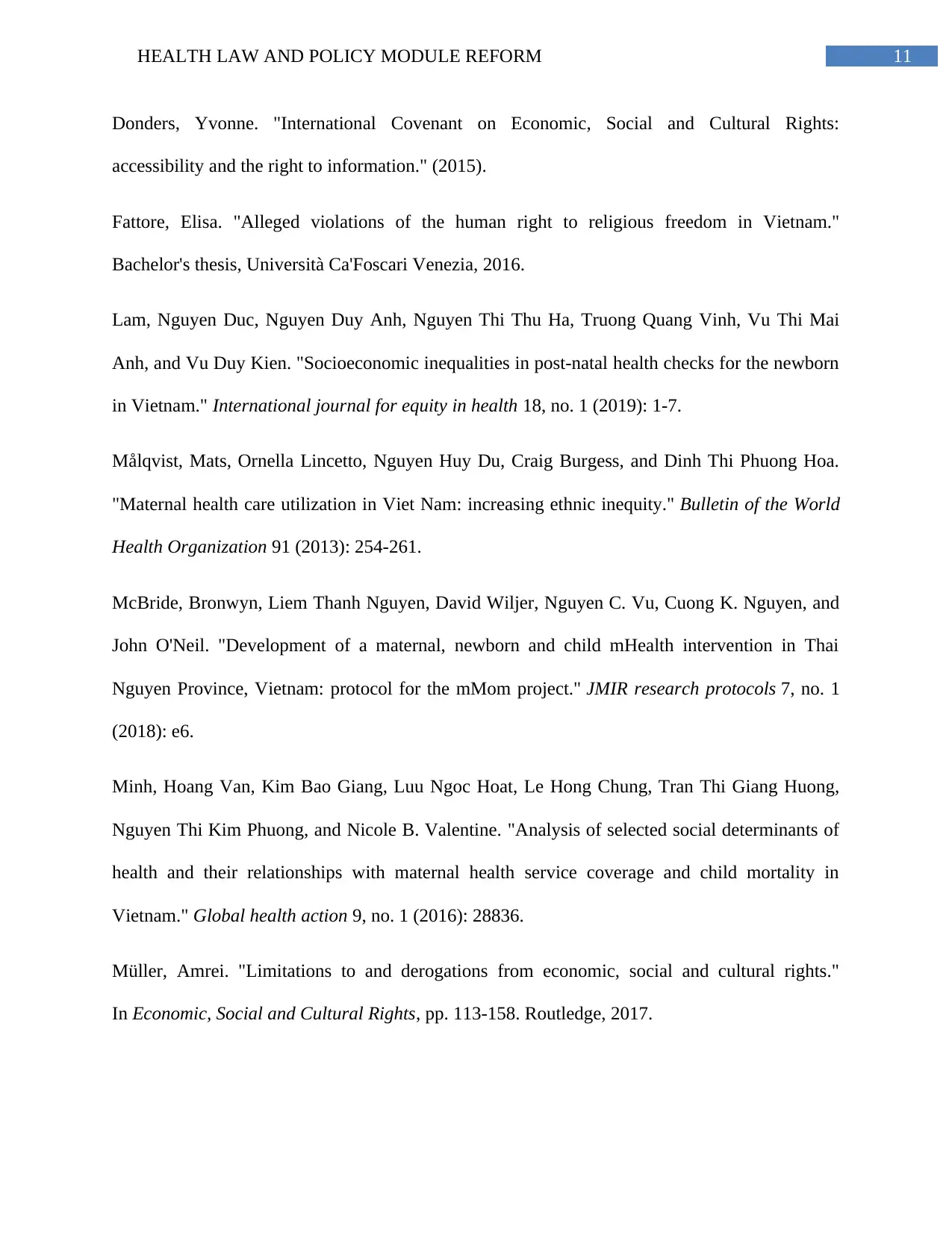
11HEALTH LAW AND POLICY MODULE REFORM
Donders, Yvonne. "International Covenant on Economic, Social and Cultural Rights:
accessibility and the right to information." (2015).
Fattore, Elisa. "Alleged violations of the human right to religious freedom in Vietnam."
Bachelor's thesis, Università Ca'Foscari Venezia, 2016.
Lam, Nguyen Duc, Nguyen Duy Anh, Nguyen Thi Thu Ha, Truong Quang Vinh, Vu Thi Mai
Anh, and Vu Duy Kien. "Socioeconomic inequalities in post-natal health checks for the newborn
in Vietnam." International journal for equity in health 18, no. 1 (2019): 1-7.
Målqvist, Mats, Ornella Lincetto, Nguyen Huy Du, Craig Burgess, and Dinh Thi Phuong Hoa.
"Maternal health care utilization in Viet Nam: increasing ethnic inequity." Bulletin of the World
Health Organization 91 (2013): 254-261.
McBride, Bronwyn, Liem Thanh Nguyen, David Wiljer, Nguyen C. Vu, Cuong K. Nguyen, and
John O'Neil. "Development of a maternal, newborn and child mHealth intervention in Thai
Nguyen Province, Vietnam: protocol for the mMom project." JMIR research protocols 7, no. 1
(2018): e6.
Minh, Hoang Van, Kim Bao Giang, Luu Ngoc Hoat, Le Hong Chung, Tran Thi Giang Huong,
Nguyen Thi Kim Phuong, and Nicole B. Valentine. "Analysis of selected social determinants of
health and their relationships with maternal health service coverage and child mortality in
Vietnam." Global health action 9, no. 1 (2016): 28836.
Müller, Amrei. "Limitations to and derogations from economic, social and cultural rights."
In Economic, Social and Cultural Rights, pp. 113-158. Routledge, 2017.
Donders, Yvonne. "International Covenant on Economic, Social and Cultural Rights:
accessibility and the right to information." (2015).
Fattore, Elisa. "Alleged violations of the human right to religious freedom in Vietnam."
Bachelor's thesis, Università Ca'Foscari Venezia, 2016.
Lam, Nguyen Duc, Nguyen Duy Anh, Nguyen Thi Thu Ha, Truong Quang Vinh, Vu Thi Mai
Anh, and Vu Duy Kien. "Socioeconomic inequalities in post-natal health checks for the newborn
in Vietnam." International journal for equity in health 18, no. 1 (2019): 1-7.
Målqvist, Mats, Ornella Lincetto, Nguyen Huy Du, Craig Burgess, and Dinh Thi Phuong Hoa.
"Maternal health care utilization in Viet Nam: increasing ethnic inequity." Bulletin of the World
Health Organization 91 (2013): 254-261.
McBride, Bronwyn, Liem Thanh Nguyen, David Wiljer, Nguyen C. Vu, Cuong K. Nguyen, and
John O'Neil. "Development of a maternal, newborn and child mHealth intervention in Thai
Nguyen Province, Vietnam: protocol for the mMom project." JMIR research protocols 7, no. 1
(2018): e6.
Minh, Hoang Van, Kim Bao Giang, Luu Ngoc Hoat, Le Hong Chung, Tran Thi Giang Huong,
Nguyen Thi Kim Phuong, and Nicole B. Valentine. "Analysis of selected social determinants of
health and their relationships with maternal health service coverage and child mortality in
Vietnam." Global health action 9, no. 1 (2016): 28836.
Müller, Amrei. "Limitations to and derogations from economic, social and cultural rights."
In Economic, Social and Cultural Rights, pp. 113-158. Routledge, 2017.
⊘ This is a preview!⊘
Do you want full access?
Subscribe today to unlock all pages.

Trusted by 1+ million students worldwide
1 out of 13
Related Documents
Your All-in-One AI-Powered Toolkit for Academic Success.
+13062052269
info@desklib.com
Available 24*7 on WhatsApp / Email
![[object Object]](/_next/static/media/star-bottom.7253800d.svg)
Unlock your academic potential
Copyright © 2020–2025 A2Z Services. All Rights Reserved. Developed and managed by ZUCOL.





